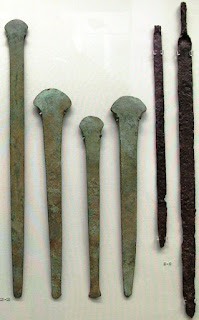

The Story of Indian Money Part II
The Harappan era (Mature phase ~ 3500 B.C. – 1900 B.C.)
The Origins of Money are vitally linked to three important factors; one, the beginning of cities, and the second, trade including within the city and outside its environs.
The third and the most important factor was the beginning of Man’s ability to count objects and thus maintain accounts. The earliest form of writing is not historical or poetic or literary material but accounts of traders!
This is true of all ancient civilizations like the Sumerian, Indus (Harappan) or the Chinese where writing symbols were invented initially to maintain accounts of trade.
The next phase in the Indian sub-continent’s development was the beginning of the Harappan civilisation around 3500 B.C in the North-Western and Western region of the Indian sub-continent popularly dubbed as India’s first urbanisation era by modern historians.
The Harappan civilisation was indeed India’s first tryst with urban culture and international trade. The Harappan people traded with the Mesopotamian people extensively as evidenced by exchange of pottery, seals and other objects through middlemen from Dilmun (modern Bahrain).
The Harappans evolved newer scientific advances like metallurgical objects, exact weighing system, innovative ship-building techniques, cities with advanced municipal sewage systems and multi-storeyed brick houses; however, not much has been discovered about their exact medium of exchange for their ‘international’ transactions.
The theory that Harappan seals were currency has been discounted by eminent scholars. Alternatively, it has been suggested that the presence of huge ‘granaries’ (probably owned by the state) may have been the ‘storehouses of value and wealth’ in the Harappan economy. Like many other aspects of the Harappan civilisation, Harappan currency remains one of the greatest enigmas that defy logic and solution.
However, the presence of some form of currency is most plausible thanks to the presence of exact weights. The Harappan weights were found in Bahrain in modern excavations in recent times suggesting that the weights were uniform in the two regions and used to quantify the buying and selling of trade goods between the two people.
Another pointer to a Harappan currency is the Harappan familiarity with the use of gold for ornamentation. Thus, Harappan currency may have been bullion most probably gold as gold objects are common in Harappan sites as opposed to silver.
Thus, Harappan era represents a monetary puzzle in the history of Indian money due to lack of definite evidence of a Harappan currency. However, other evidences like organized weight system, familiarity with gold as a precious commodity and a sophisticated system of trading point to the existence of a definite form of exchange system in the period.
(To be continued)
















.JPG)
.JPG)







